|
English Transfer Printed Pottery
| By Michael Weinberg
Editor, Transferware Collectors Club Bulletin
Posted May 2013
|
 |
The origins of transfer-printed pottery
-“transferware” for short -are murky, to say the least, but they date to mid-18th century England. Prior to the 1780s, decorated ceramic items were either imported from China or were hand-painted designs before the object was glazed and fired in a kiln. Chinese Export (Canton, Nanking, etc.) came into England by the ton, often as ballast on ships from the Orient. English potters competed against these imported goods and tin-fired ceramics from Continental Europe (Delft) with attractive, hand-painted alternatives. But it wasn’t until the advent of technological advances in the 1750s and the material demands of an emerging middle class that the British pottery industry would be taken in a new direction: transfer printed pottery.
John Brooks and later Robert Hancock were among the early craftsmen whose work led to the perfection of transfer-printed pottery. There is even some speculation that Benjamin Franklin tinkered with the concept of printing designs on ceramics.1 Sadler and Green of Liverpool are credited with perfecting a process for producing printed designs on pottery. One design they used, which was adopted by other potters including Josiah Wedgwood, was a black-printed pattern that has come to be known as Exotic Birds. It is said that this pattern was popular in Colonial Williamsburg. Josiah Spode, using technology developed by other potters, perfected a method for producing the first underglaze blue transferware, first on porcelain and then on the sturdier and less expensive earthenware. Scenes depicted included Oriental designs, as well as exotic views of the Far East, especially the emerging British presence in India; the covered serving dish pictured below dates to c. 1810 and is a good example of the crisp images produced by Spode at this very early date.
|
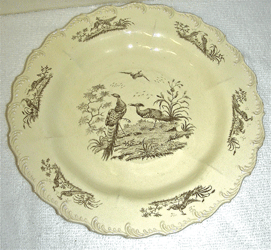
|
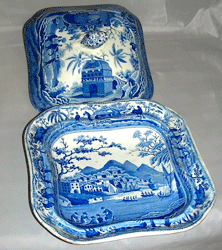
|
|
Black transfer printed Exotic Birds on creamware,
one of the first
transfer-printed patterns and
one popular in Colonial America.
|
Early Spode transfer-printed scene on a covered
vegetable dish from the
Caramanian Series, c. 1810.
|
In oversimplified terms, the production of transferware requires several steps. First, a copper plate is engraved with a design, usually adapted from a source print2; this could take up to six months. Next, a copper plate is “oiled” with boiled linseed oil and then colored with special mineral-based ink dyes (which is why colors were limited until technology started developing chemical-based dyes); only mineral-based dyes could stand up to the extreme heat of the kilns. Then, a thin tissue paper is applied to the plate, rubbed and then carefully removed. The tissue paper with the decoration is applied by hand to the undecorated pottery, called the “biscuit,” rubbed with a piece of soaped flannel cloth, and the color image is thus transferred to the surface of the pot. The tissue paper is washed off, and the decorated piece is then fired in large kilns. While very labor intensive, these kilns, which dotted the Staffordshire region of England, produced millions of pieces of pottery for both the domestic British and export markets.
As you can imagine, the tissue paper with the decoration was very delicate, and often, the pieces to be decorated were quite small—think about trying to apply fragile, wet tissue paper around the inside edge of a teacup, for example, or under the handle of a teapot. Generally speaking, the only people with fingers and hands small enough to do this work were 10- to 12-year-old girls, and they were employed (perhaps a generous term) extensively in the Staffordshire potteries.
|
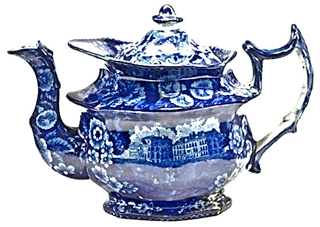
|
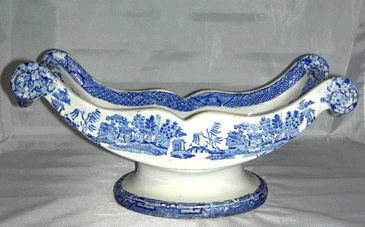
|
|
A dark blue teapot showing the Alms House
in Baltimore, an example of a public building
often shown on American views.
|
Willow-decorated cheese cradle,
a rare form.
|
The area around Staffordshire attracted dozens of potters because of the natural clays in the region and its proximity to coal for the kilns. Today, the generic term Staffordshire is applied to pottery coming from numerous towns in this region of England.
The earliest transfer-printed patterns leaned heavily on Chinoiserie designs. Chinese Export, after all, was the model. Perhaps the most popular (even today) of these Chinese-influenced designs is the ubiquitous Willow pattern. It was used on all kinds of wares and with hundreds of variations in the basic design. Today, many collectors specialize in these Willow variations.
In addition to the Willow varieties, English potters in the early 19th century found willing customers for all sorts of decorations, ranging from beautiful landscapes highlighting the stately British manor houses, castles and cathedrals, to bucolic scenes of shepherds and their flocks, and other peasants working and playing in the countryside. Quaint and charming domestic scenes were also popular, along with scenes from literary works and British and Continental history. Also, of course, people loved dishes with animals, fruits, and flowers. Transfers of dogs, especially, were popular, both domestic pets and aggressive hunting canines, as were scenes with wild, exotic (for the early 19th century) and fanciful creatures. One can only imagine what it was like eating with a lion or a polar bear staring up at you from your dinner plate, especially when you had never encountered one of these beasts, even in pictures.
|
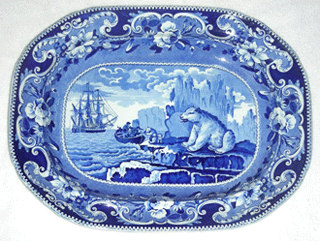
|
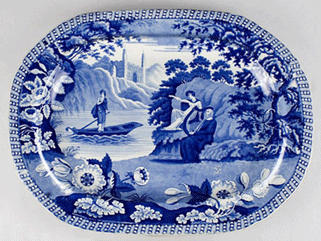
|
|
Fascination with wild and exotic animals was evident
with this open serving dish showing a rather friendly-looking polar bear facing hunters.
|
Literary scenes were popular, including this rendition of “The Lady of the Lake” from the Arthurian legend, note Merlin sitting on the shore.
|
Early examples of blue-printed transferware and wares for the British market were primarily medium or royal blue. The dark cobalt blue transfers that we have come to appreciate and collect in this country were made mostly for the American market. One theory as to why there was a color distinction between the U.S. and English markets is architectural-related: British homes, both urban and country, were dark inside with relatively small windows for the size of the rooms (a rather sweeping statement, your author admits, and one that my British friends might challenge), while American houses were brighter with large windows, relatively speaking, and the furniture either painted or made from lighter woods. The dark blue transfers (and later the colored transfers) simply did not show up very well on an English table.
Dark blue American Historical Staffordshire’s popularity began to wane about 1830, and in its place, transfers in other colors—red (pink), green, brown, black and purple—were sold. The scenes on these wares were both historical and romantic, and by the 1840s, Flow Blue and later Mulberry (the black transfer equivalent of Flow Blue) appealed more to public tastes. The last quarter of the 19th century was marked by the popularity of the Aesthetic Movement, designs that reflected the sensual pleasures that the movement professed, such as the double oil and vinegar flask pictured here.
|
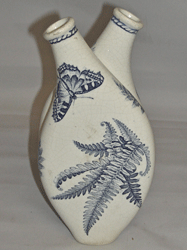
|
An unusual oil and vinegar cruet with fern leaves and butterflies and design elements common to Aesthetic Movement transferware.
|
With the conclusion of the Napoleonic Wars and the War of 1812, British potters found an eager and expanding market for their goods on this side of the Atlantic. While many patterns exported for the young United States show rural and domestic scenes similar to those popular in England, an important segment of the American market has come to be known as American Historical Staffordshire. The images depicted on this pottery showed exclusively American themes. Some were important public buildings, some showed the spectacular scenery of the Americas, and others depicted the growing American cities. To demonstrate just how entrepreneurial the British potters were, some even depicted American victories over the British in the War of 1812 (MacDonough’s Victory on Lake Champlain) and American Revolutionary War heroes such as Lafayette. Popular subjects also were municipal buildings, hospitals and asylums for the deaf and dumb, and even the prisons.
The locations for most of the Historical American views are found in or near the cities of the Northeast. Boston, New York, Philadelphia and Baltimore dominate, as one would expect. One series with quite a large number of different transfers was done by James and Ralph Clews, and it focuses on views of the Hudson River Valley. Unlike other American views of the early period (1820-1830), this series was printed in light blue and a variety of colors. The Capitol Building in Washington, D.C., and the President’s House also decorated plates and platters, and Washington’s home at Mount Vernon was honored, as well. Also included are some relatively obscure places such as the Marine Hospital in Louisville, Ky., Transylvania University, Lexington, Ky., and Shannondale Springs, Va.
|
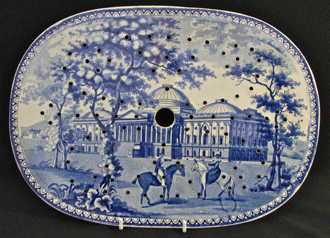
|
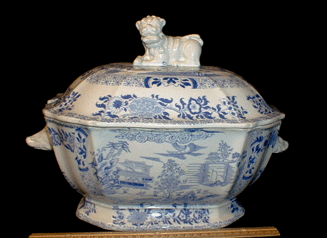
|
|
A drainer for a meat platter showing
the
U.S. Capitol in Washington, D.C.,
as it looked in the 1830s.
|
A very large jambalaya tureen with a foo dog finial in the Willow pattern. This tureen was from Mr. Ruddock’s Hotel in New Orleans, a boarding house dating c. 1830.
|
Southern views are relatively scarce. A series by Thomas Mayer in very dark blue shows the Coats of Arms of the States (original 13 colonies) with Virginia, the Carolinas and Georgia represented. John and William Ridgway produced a very attractive series called “Beauties of America” (some consider this to be the most attractive of all the American views) with the “Exchange, Charleston (SC)” and “The Bank of Savannah” represented. The “Charleston Exchange” is also found in a series by Ralph Stevenson, and an 1840s series, usually found in colors other than blue, shows “Riceborough, GA” and New Orleans. “Riceborough” and the “Natural Bridge in Virginia” appear in Enoch Wood’s “Celtic Series.”
Transferware in the antebellum South remains a fertile field for research. Willow pieces from the 1820s or earlier are known with New Orleans hotel marks, and there are documented Staffordshire importers in Charleston and several in New Orleans. Transferware was also carried along the Mississippi and into frontier outposts in Nebraska and Iowa, and there are contemporary California views of the Gold Rush, mostly on children’s dishes.
Collecting Staffordshire, historical or romantic, is best done with several books in hand. There are hard-to-find classics and modern updates that provide excellent reference material. Readily available are two books by Jeffrey Snyder: Historical Staffordshire: American Patriots and Views, and Romantic Staffordshire Ceramics, both published by Schiffer. Sam Laidacker published a two-volume set in the 1950s entitled, Anglo-American China; Part I deals with American views, and Part II covers English scenes. David and Linda Arman have updated the American views information in their Historical Staffordshire: An Illustrated Check-List (privately published).
Probably the most comprehensive work thus far is a two-volume Dictionary of Blue and White Printed Pottery by A. W. Coysh and R. K. Henrywood, published by the Antique Collectors Club; Mr. Henrywood is in the process of up-dating The Dictionary. Romantic Staffordshire: Cup Plates and Early Victorian China, in three volumes, by Petra Williams covers many romantic transfers. Another classic work is American Historical Views on Staffordshire China by Ellouise Baker Larsen, readily available in a Dover Publications reprint.3 The most recently published works include Encyclopedia of British Transfer-printed Pottery Patterns, 1790-1930, by Gillian Neale, part of Miller’s Collectors Series, and most recently, Extraordinary British Transferware, 1780-1840, by R. & R. Halliday.
The principle group in the United States dedicated to the appreciation and study of transferware is the Transferware Collectors Club (TCC). Their website, www.transcollectorsclub.org, is a treasure-trove of information about the subject. Numbering approximately 400 members worldwide, the group maintains an active and educational website, which includes a unique, searchable Pattern and Source Print Database. Using this database, members have access to extensive information and photographs for approximately 10,000 transferware patterns.
The TCC supports educational initiatives and provides research grants on selected transferware subjects. It holds an annual meeting with tours, lectures and workshops relating to transferware, and publishes a quarterly Bulletin with in-depth articles of general interest. Annual dues are a modest $50 per year ($60 for International members), and that permits unrestricted access to the website and the database and to all back issues of the TCC Bulletin. For more information on membership, see the website. Much of the information used in this article was gleaned from two online exhibits supported by the TCC and available to anyone from the website: “Spode Exhibition on Line” (www.spodeceramics.com) and “Patriotic America, an online exhibition” (www.americanhistoricalstaffordshire.com).
-------------------------------------
ENDNOTES:
1 “Did Benjamin Franklin Invent Transferware,” by Wendy W. Erich, The Burlington Magazine, July, 2010, research funded by the Transferware Collectors Club through a grant from the Paul and Gladys Richards Foundation.
2 An exciting and emerging area for collectors is locating the source prints used in the production of transferware. Found generally in books of the period, these source prints can be a rich source of information for the transferware collector.
3 A major portion of Ms. Larsen’s collection now forms the basis of the transferware holdings of the Smithsonian Institution in Washington. Not usually on public display, the Larsen collection is a fascinating glimpse of one aspect of early 19th century American material culture, if one is lucky enough to view it.
|